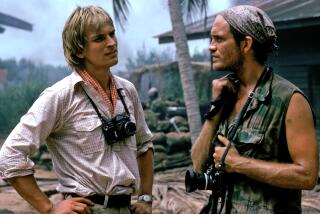London Design Museum puts Saul Bass in the title
- Share via
LONDON — Horizontal and vertical bars come and go, evoking the mania of Norman Bates as the opening credits roll in “Psycho.” A mass of Las Vegas neon whirls as the body of Robert De Niro falls at the beginning of “Casino.”
Such was the genius of Saul Bass, the American graphic designer who specialized in movie title sequences and worked with Alfred Hitchcock, Martin Scorsese, Otto Preminger, Stanley Kubrick and others to capture the essence of their most memorable films -- without giving the plots away.
Bass turned dull opening rolls of names into spectacles, arguing that an audience should be engaged with a movie from its first frame.
Now, London’s Design Museum is staging a major retrospective of the work of Bass, who was 75 when he died in Los Angeles in 1996.
“We thought it would be a fantastic exhibition, and we asked the Saul Bass archive at the Academy of Motion Picture Arts and Sciences in Los Angeles for loans,” said Donna Loveday, curator for the Design Museum.
“The result surpasses our expectations. We didn’t expect we could show so many title sequences, about 25 to 30, and lenders were generous with films and posters, letters and storyboards,” she said.
Other famous Bass sequences include a jagged cutout of an arm for Preminger’s “The Man With the Golden Arm,” and a splayed, segmented body with the title scattered over it for Preminger’s “Anatomy of a Murder.” He also designed many key scenes in Hitchcock’s “Psycho.”
Bass filmed a revolving stagecoach wheel for William Wyler’s “The Big Country” and a cat on a city street for “Walk on the Wild Side,” directed by Edward Dmytryk. He made spiraling circles for Hitchcock’s “Vertigo” and a hand tearing paper to reveal cast names for Preminger’s “Bunny Lake Is Missing.”
Scorsese, who directed “Casino,” said Bass always understood how a movie worked, and his titles “embedded the mysteries of those films but somehow never gave away their secrets.”
Bass believed a film’s title sequence should consist of a single image in a highly reductive form, “terribly simple and metaphorical, but at the same time provocative.”
Bass, who appears in the retrospective in a filmed interview, opened his own design studio in Los Angeles in 1952, and his first movie title sequence -- a flame superimposed on a rose for Preminger’s “Carmen Jones” in 1954 -- made him the first graphic designer to be granted a screen credit by the Directors Guild of America.
Bass won an Academy Award in 1968 for his short film “Why Man Creates,” but his talents remained in title sequencing.
The exhibition opened July 17 and runs through Oct. 10.
More to Read
The biggest entertainment stories
Get our big stories about Hollywood, film, television, music, arts, culture and more right in your inbox as soon as they publish.
You may occasionally receive promotional content from the Los Angeles Times.










